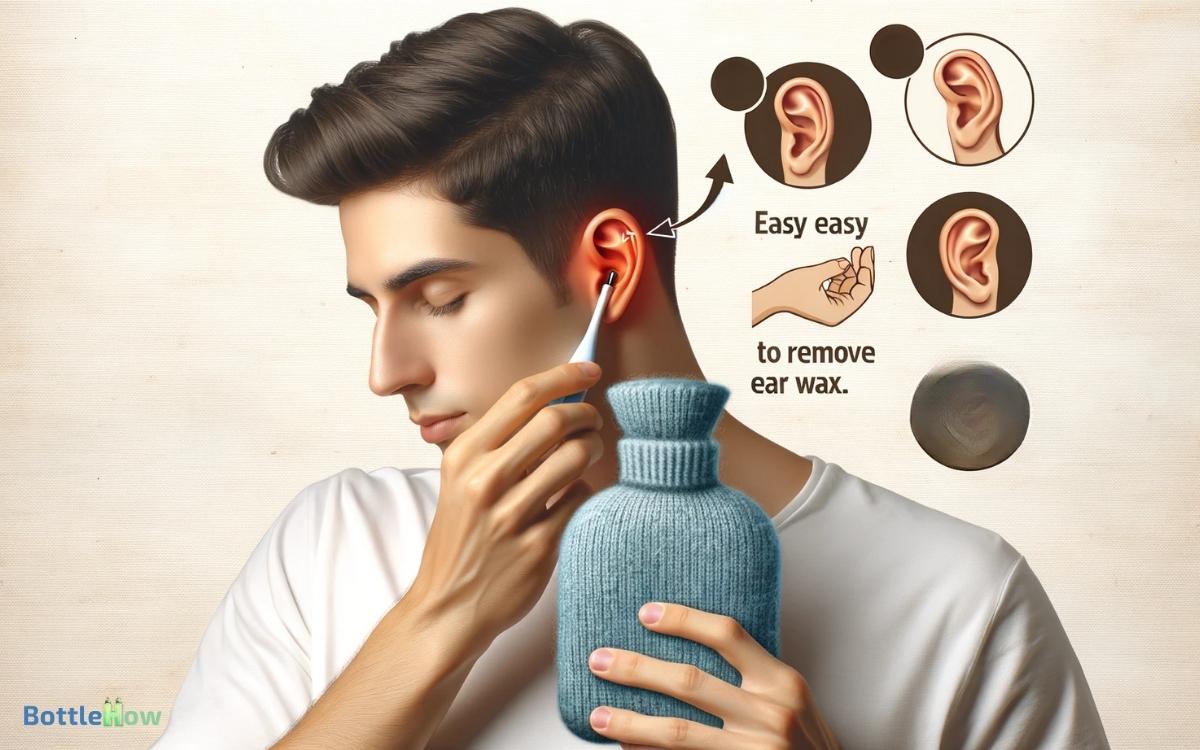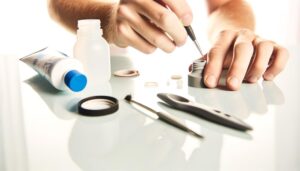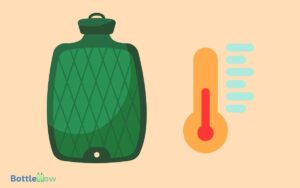Hot Water Bottle to Remove Ear Wax: Easy & Quick Steps!
Make sure a hot water bottle is an effective method for softening ear wax, which eases removal. Fill the bottle with water heated to around 120°F (49°C) and wrap it in a soft cloth.
Gently apply it to your ear for 10-15 minutes. This consistent warmth helps soften cerumen and facilitates the self-cleaning process.
Monitor the water temperature to avoid burns and consult a healthcare professional if discomfort persists.
Regular use, about once or twice a week, helps prevent excessive buildup. Understanding how to optimize this technique can enhance ear health and comfort.

Key Takeaways
Understanding Ear Wax
Ear wax, or cerumen, serves as a protective barrier for the ear canal, preventing debris, bacteria, and other foreign particles from causing harm. It’s primarily composed of secretions from sebaceous and ceruminous glands, mixed with dead skin cells.
Cerumen is hydrophobic, which helps protect the skin of the ear canal from water and moisture. Additionally, it has antimicrobial properties that inhibit bacterial and fungal growth.
The self-cleaning mechanism of the ear canal involves the natural migration of ear wax from the inner ear to the outer ear, where it can be easily removed.
This process is facilitated by jaw movements, such as talking and chewing, which help transport cerumen outward.
Understanding these properties underscores its essential role in ear health.
Problems With Ear Wax Buildup
You might experience significant hearing loss issues due to excessive ear wax buildup, which can obstruct the ear canal.
This condition often leads to various symptoms of ear discomfort, including pain, itching, and a feeling of fullness.
Additionally, accumulated ear wax increases the risk of infections, as it creates an environment conducive to bacterial growth.
Hearing Loss Issues
Accumulation of cerumen, commonly known as ear wax, can lead to significant hearing impairment and discomfort if not properly managed.
When ear wax builds up, it can obstruct the ear canal, preventing sound waves from reaching the eardrum effectively. This blockage can result in conductive hearing loss, where the efficiency of sound transmission is reduced.
Additionally, ear wax buildup can cause a reduction in the clarity of sound, making it difficult to understand speech and other auditory signals. Regular removal of excess ear wax is essential to maintain peak auditory function.
Techniques such as irrigation, manual removal, or using a hot water bottle can help manage ear wax buildup and mitigate associated hearing issues.
Ear Discomfort Symptoms
Experiencing discomfort due to cerumen impaction often manifests through symptoms such as earache, itching, and a sensation of fullness in the ear canal.
You might also notice tinnitus, which is a ringing or buzzing sound in the ear, and in some cases, vertigo—a feeling of dizziness or imbalance.
These symptoms occur because earwax can obstruct the ear canal, leading to pressure and irritation on the surrounding tissues. Additionally, excessive earwax may trap water or debris, further exacerbating discomfort.
It’s important to recognize these symptoms early, as they can indicate significant cerumen buildup. Professional evaluation may be necessary to avoid potential complications and guarantee proper management of ear health.
Infection Risk Factors
Cerumen impaction greatly increases the risk of ear infections by creating an environment conducive to bacterial and fungal growth.
When ear wax builds up excessively, it can trap moisture and debris, promoting microbial proliferation.
You should be aware that inflammation from infection can lead to symptoms such as pain, hearing loss, and discharge. Specifically, otitis externa, commonly known as swimmer’s ear, is a frequent consequence of such conditions.
Additionally, cerumen impaction can compromise the ear canal’s acidic pH balance, weakening its natural defense mechanisms. It’s essential to manage ear wax buildup promptly to mitigate these risks.
Utilizing a hot water bottle may aid in softening cerumen, but always consult a healthcare professional for effective and safe removal techniques.
Traditional Methods of Removal
In managing ear wax buildup, you’ve likely encountered traditional methods such as oil-based solutions and the cautious use of cotton swabs.
Evidence suggests that oils like mineral or baby oil can soften cerumen, facilitating its natural expulsion.
However, improper use of cotton swabs can push wax deeper into the ear canal, leading to complications.
Oil-Based Solutions
Using oil-based solutions like mineral oil or olive oil can effectively soften ear wax, facilitating its removal. Applying a few drops into the ear canal helps break down the wax, making it easier to expel naturally.
You should lie on your side, allowing the oil to stay in the ear for several minutes. This method is non-invasive and safe when done correctly.
Here’s a quick comparison of common oil-based solutions:
| Oil Type | Benefits | Application Method |
|---|---|---|
| Mineral Oil | Easily accessible, effective | Dropper, 2-3 drops |
| Olive Oil | Natural, gentle on skin | Dropper, 2-3 drops |
| Almond Oil | Moisturizing properties | Dropper, 2-3 drops |
Cotton Swabs Caution
Though widely used, cotton swabs can push ear wax deeper into the ear canal, increasing the risk of impaction and potential damage to the ear.
When you insert a cotton swab, you disrupt the natural migration of cerumen, or ear wax, which ordinarily moves outward.
This disruption can lead to cerumen impaction, causing symptoms like hearing loss, pain, and tinnitus.
Additionally, aggressive use of cotton swabs might abrade the sensitive skin of the ear canal, heightening the risk of infection.
Clinical guidelines from organizations such as the American Academy of Otolaryngology recommend against using cotton swabs for ear wax removal.
Instead, consider safer alternatives like ear drops or professional cleaning by a healthcare provider to maintain peak ear health.
Why Use a Hot Water Bottle
A hot water bottle can effectively soften ear wax, facilitating its removal and providing relief from discomfort. The gentle heat helps to loosen stubborn wax, making it easier to drain naturally. Using a hot water bottle for blocked ears can also promote blood circulation in the area, reducing any associated pain or pressure. For best results, wrap the bottle in a soft cloth and rest your ear against it for several minutes.
Utilizing a hot water bottle allows for a controlled application of heat, which can be beneficial in loosening hardened cerumen.
Unlike other methods, this approach minimizes the risk of injury to the delicate structures within the ear canal.
The heat from the bottle promotes vasodilation, enhancing blood flow and potentially accelerating the natural expulsion of ear wax.
Moreover, the warmth provides a soothing sensation, alleviating any associated pain or irritation.
How Heat Softens Ear Wax
Applying heat to the ear canal helps to soften ear wax by raising its temperature, which reduces its viscosity and makes it easier to remove.
When you apply a hot water bottle, the heat penetrates the ear canal, causing cerumen (ear wax) to become more pliable.
Elevated temperatures alter the physical properties of the cerumen, decreasing its density and adhesion to the ear canal walls.
This process allows for easier extraction, either through natural expulsion or with the aid of ear irrigation techniques.
Using heat effectively minimizes the risk of impaction and discomfort associated with hardened ear wax.
Clinical studies support the efficacy of heat application in softening ear wax, making it a practical and non-invasive method for ear care.
Choosing the Right Hot Water Bottle
Selecting the appropriate hot water bottle is crucial for ensuring effective and safe application of heat to soften ear wax.
You should choose a hot water bottle made of durable, high-quality rubber or thermoplastic to guarantee it retains heat effectively.
Opt for a smaller-sized bottle, as it provides more targeted heat application, reducing the risk of burns.
Ensure the bottle has a secure, leak-proof cap to prevent any accidental spills. It’s also beneficial to select one with a removable, washable cover; this keeps the bottle clean and offers additional insulation.
Preparing the Hot Water Bottle
Once you’ve selected the right hot water bottle, the next step is to prepare it properly to guarantee it delivers safe and effective heat for ear wax softening.
Start by filling the bottle with water that’s approximately 104°F (40°C) to avoid burns or discomfort. Make sure the water level is about two-thirds full to allow flexibility.
Check for leaks: Before sealing, confirm the bottle is free from any visible tears or punctures.
Secure the cap tightly: A well-fastened cap prevents water from leaking during use.
Wrap the bottle: Enclose it in a soft cloth to moderate the heat and protect your skin.
This method ensures the hot water bottle maintains a consistent, gentle warmth, optimizing the ear wax softening process.
Steps to Apply Heat
To effectively apply heat using a hot water bottle for ear wax removal, begin by ensuring the bottle is filled with water at a safe, moderate temperature.
You should then use a protective cloth or cover to prevent direct skin contact and minimize the risk of burns.
Preparing the Bottle
Start by filling the hot water bottle with water heated to approximately 120°F (49°C) to guarantee ideal warmth for softening ear wax. Maintaining this temperature is crucial to ensure safety and efficacy.
Next, confirm the hot water bottle is securely sealed to prevent any leakage. To enhance safety and comfort, wrap the bottle in a soft cloth or towel.
This additional layer will:
- Prevent direct skin contact with the hot surface, minimizing the risk of burns.
- Help retain the heat for a longer duration, ensuring consistent warmth.
- Provide a comfortable barrier for resting against the ear.
Safe Application Tips
Guaranteeing the proper application of heat, place the wrapped hot water bottle gently against the affected ear for 10-15 minutes to effectively soften ear wax.
First, make sure the water temperature isn’t excessively hot to avoid burns. Use a soft cloth or towel to wrap the bottle, providing a barrier against direct heat.
Position yourself comfortably, allowing the heat to penetrate the ear canal. Monitor the time closely to prevent overheating.
After the designated time, remove the hot water bottle and allow the ear to cool naturally. This process will facilitate the safe and gradual loosening of ear wax, making subsequent removal procedures easier and more effective.
Always consult a healthcare professional if discomfort persists or if you experience any adverse reactions.
Frequency of Use
Although individual needs may vary, using a hot water bottle for ear wax removal should generally not exceed once or twice a week to prevent potential skin irritation or burns. Overuse can compromise the integrity of your skin and lead to adverse effects.
To visualize the process, consider the following:
- Steam rising from the hot water bottle, gently softening ear wax.
- Warmth radiating through a cloth, soothing any discomfort.
- Ear wax loosening and naturally draining over time.
Adhering to a moderate frequency helps you minimize risks while effectively managing ear wax buildup.
Clinical guidelines recommend this interval to balance efficacy and safety, thus avoiding damage to sensitive ear tissues and skin. Always consult your healthcare provider for personalized advice.
Signs of Effective Treatment
When using a hot water bottle for ear wax removal, you’ll know the treatment is effective if there’s a noticeable reduction in ear discomfort, improved hearing, and visible drainage of softened wax.
These indicators suggest that the heat has sufficiently softened the cerumen, facilitating its removal.
Here’s a brief overview of the signs:
| Sign | Description | Implication |
|---|---|---|
| Reduction in Discomfort | Less pain or irritation in the ear | Indicates wax is loosening |
| Improved Hearing | Enhanced auditory perception | Suggests blockage is being cleared |
| Visible Drainage | Presence of softened wax exiting the ear canal | Confirms wax is being effectively removed |
Monitoring these signs ensures you’re on the right path to achieving peak ear health.
Precautions and Safety Tips
Using a hot water bottle for ear wax removal demands strict adherence to safety protocols to prevent burns and further complications.
Confirm the water temperature isn’t excessively hot by testing it on your wrist first. Overheating can damage the sensitive skin around your ear.
- Temperature Check: Make sure the water is comfortably warm, not scalding.
- Protective Layer: Always wrap the hot water bottle in a towel to avoid direct contact with the skin.
- Duration Limit: Limit the application time to 10-15 minutes to prevent thermal injury.
When to Seek Professional Help
If you experience persistent ear pain, hearing loss, or any signs of infection, seeking professional medical assistance promptly is crucial.
Symptoms such as discharge, dizziness, or tinnitus could indicate a more serious underlying condition that necessitates expert evaluation. A healthcare provider can perform otoscopic examination to accurately diagnose the issue.
They may utilize irrigation, microsuction, or manual removal techniques to safely clear ear wax. Avoid using cotton swabs or inserting objects into your ear canal, as these can cause further impaction or damage.
Self-treatment methods, like hot water bottles, shouldn’t replace professional care when symptoms are severe or unresponsive. Early intervention can prevent complications and promote excellent auditory health.
Conclusion
Using a hot water bottle to remove ear wax can be a safe and effective method when done correctly. Just like melting butter, the gentle heat softens the wax, making it easier to remove.
However, make sure you follow safety precautions and monitor the frequency of use. Always watch for signs of effective treatment, and don’t hesitate to seek professional help if needed.
Remember, your ear health is paramount, and proper care can prevent complications.





